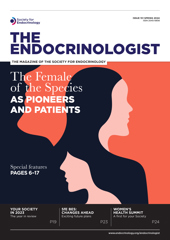Lucilla Poston looks at what has been achieved, and what remains to be done, in our quest to address the most pressing issues in obstetrics.
When I was appointed in 1995 to the position of Professor, and shortly afterwards, as Head of the Department of Women’s Health, it was my brief to develop a research team to interrogate the most pressing, unanswered questions in clinical obstetrics.
Located in a clinical department serving a large inner-city multi-ethnic population, these were all too obvious: low birthweight, pre-eclampsia and hypertensive disease, and premature birth. As time went on, and as the pandemic of obesity took hold, gestational diabetes became a major issue, as did the recognition of maternal mental health problems. Ever present were the inequalities in pregnancy outcome, especially amongst ethnic subgroups and socioeconomically deprived populations.
As a scientist (physiologist) by training, I was, and remain, committed to understanding the mechanisms of pregnancy complications through scientific discovery. However, most improvements in antenatal care over the last 30 years have arisen from the introduction of better antenatal surveillance, and timely intervention.
PAST PROGRESS
Technological advances, especially imaging modalities, have played a major role (e.g. early detection of fetal anomalies, a prematurely shortened cervix and abnormal fetal growth). Biotechnological advances have been remarkable in improving diagnosis, including early embryo preimplantation genetic diagnosis, the emergence of maternal blood cell-free fetal DNA analysis for diagnosis of chromosomal abnormalities,1 and the development of the placenta growth factor test in detection and management of pre-eclampsia.2
Continuous and/or home-based digital monitoring of physiological variables, such as blood pressure and glucose, are increasingly adopted and will transform care. Some have already proved their worth, including hybrid ‘closed-loop’ insulin therapy for type 1 diabetes control in pregnancy.3
These, together with new evidenced-based management pathways for antenatal care and delivery, are increasingly improving safety and clinical outcomes.
Public health campaigns have also contributed, especially in the UK, in achieving a reduction in smoking and in adolescent pregnancies, both associated with poor outcomes.
PRESENT CONCERNS
There is a limit, however, to how strategies to improve antenatal care management will further reduce risks to the health of the mother or fetus, without a fundamental shift in knowledge of the root causes. Clinical trials in obstetrics will grind to a halt without new discoveries translating to novel treatments; this is already becoming evident.
So, do we understand more about the root causes of the common complications of pregnancy? We do, but these have mostly yet to be translated into practice. There have been no major advances in the prevention or reversal of spontaneous premature labour or of fetal growth restriction. Low dose aspirin has been proven to reduce the risk of pre-eclampsia,4 especially of early onset, but we have little else to offer, as the root causes remain enigmatic. Maternal death rates in the UK are highest amongst black women, a clear mark of failure to address the social and biological causes of inequalities in pregnancy outcomes.
FUTURE POSSIBILITIES
Recent major advancements in cell biology, omics and other high throughput technologies nonetheless give great cause for optimism. Single cell RNA sequencing and proteomics, even in cells in situ, can pin-point responsible genes and proteins. The relative affordability and high throughput of genomic and metabolomic technologies adds these to the armoury of methodological advances.
We now know, for example, that small exosomes carrying a cargo of physiological and pathological messengers, including proteins, lipids, mRNA and miRNA derived from the placenta, provide key intercellular communication between placenta and mother in normal and abnormal pregnancies.5 These may influence maternal innate and adaptive immunity, or cardiovascular function, amongst other maternal pathways known to adapt to pregnancy or to be pathologically compromised. Exosomes/their messengers have potential as biomarkers in diagnosis, and also as therapeutic targets. Externally sourced stem cell exosomes may also have therapeutic potential.
The recent discovery of a gene variant which predisposes to hyperemesis gravidarum (morning sickness),6 if it achieves its translational promise to provide a novel therapy, could have a major impact on the well-being of pregnant women.
There is also renewed hope for better understanding of pre-eclampsia, where partial failure of the process of placentation in the first few weeks of pregnancy, due to limited trophoblast invasion of the maternal spiral arteries, leads to poor placental blood flow and growth restriction. Following years of frustration in defining the triggers for derivation of embryonic trophectoderm stem cells to cytotrophoblast and then invasive or invading extravillous trophoblast lineages, understanding of these pathways has recently escalated.7 This will inevitably lead to definition of the permissive or inhibitory signalling pathways that control the invasion process, and potential for early pregnancy therapeutic targets.
Environmental exposures, such as endocrine disruptors and particles derived from fuel combustion, have also been implicated in pre-eclampsia through interference with normal placental function; here the solution is obvious.
Understanding the mechanisms of gestational diabetes has also moved forward, with nuclear magnetic resonance metabolomics providing the first holistic metabolic profile of the disease, demonstrating, as well as glycaemia, a wide range of abnormalities in the lipid profile.8 We also now know that there is more than one gestational diabetes phenotype, implying that the current one-size-fits-all therapeutic regime needs review. Precision treatment is very likely to improve control and reduce macrosomia and other related complications.
The future for better targeted treatment of the common disorders of pregnancy, supported by an evidence-based aetiology, therefore remains tantalisingly ‘round the corner’, but we can realistically be hopeful.
In parallel, the reluctance to repurpose useful drugs for the treatment of cardiovascular and metabolic complications of pregnancy needs attention.9 Potentially useful therapies are frequently ‘contraindicated’ in pregnancy for no evidenced-based reason. More research into the pharmacodynamics of drugs in pregnancy, especially with regard to fetoplacental transfer, are needed to evaluate safety. We also need wider reporting of outcomes of unintended use of common therapies in pregnancy.
At the level of population health, effective strategies to ‘level up’ inequalities in pregnancy mortality and morbidity must be an immediate priority.
All these approaches are in the ‘sights’ of our research funding bodies and policymakers, and all will make a difference.
LUCILLA POSTON CBE
Professor of Maternal and Fetal Health, King’s College London
REFERENCES
- Badeau M et al. 2017 Cochrane Database of Systematic Reviews https://doi.org/10.1002/14651858.CD011767.pub2.
- Duhig KE et al. 2019 Lancet https://doi.org/10.1016/S0140-6736(18)33212-4.
- Lee TTM et al. 2023 New England Journal of Medicine https://doi.org/10.1056/NEJMoa2303911.
- Rolnik DL et al. 2017 New England Journal of Medicine https://doi.org/10.1056/NEJMoa1704559.
- Barnes MVC et al. 2023 Journal of Extracellular Vesicles https://doi.org/10.1002/jev2.12377.
- Fejzo M et al. 2024 Nature https://doi.org/10.1038/s41586-023-06921-9.
- Qin J et al. 2023 Biology of Reproduction https://doi.org/10.1093/biolre/ioad027.
- White SL et al. 2017 Diabetologia https://doi.org/10.1007/s00125-017-4380-6.
- Arman BM et al. 2022 Reproduction https://doi.org/10.1530/REP-22-0226.






